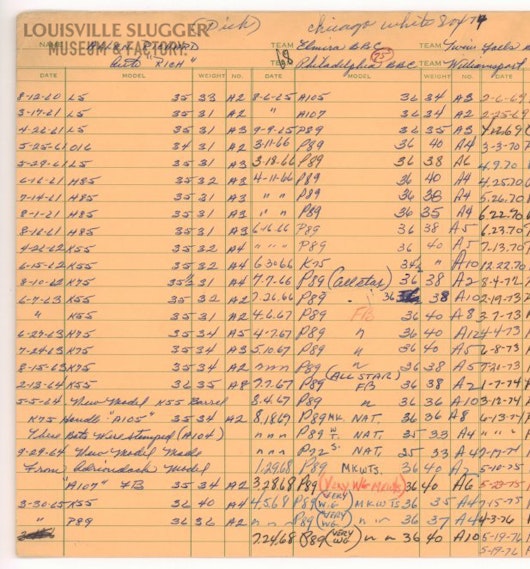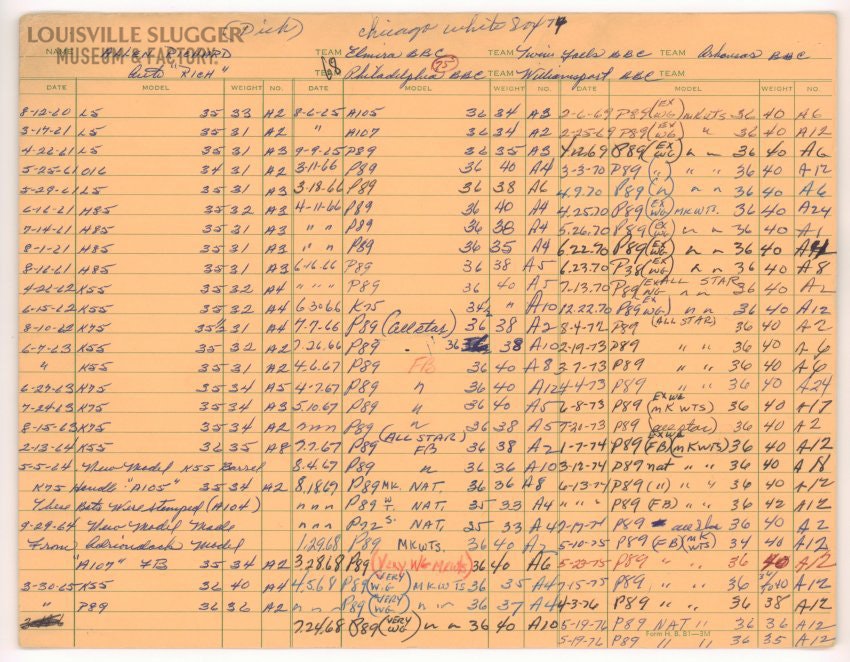Journey to the South Side
By Doug Johnson
I seem to recall it as a bright, sunny Thursday – October 1, 1959. As I was preparing to leave for school that day, my father suggested I skip school to attend a ball game. As a depression-era self-educated man, this was very unusual to say the least. You see, he had been given two box seat tickets for game one of the 1959 World Series between the Chicago White Sox and the LA Dodgers. Attending this game along with 48,103 White Sox fans solidified my team allegiance for life. (Sox winning 11 to 0 didn’t hurt either.) While they went on to lose the series I was hooked on the White Sox!
Chicago is a city of deeply divided loyalties where many diehard fans of the Sox and the Cubs can tell you more about their baseball lineage than their family’s history. I may not remember the town in Sweden where my grandparents came from, but I can tell you the starting lineup of the 1959 Chicago White Sox. Here are some of the coolest White Sox artifacts I’ve come across in my time at the museum.

Shoeless Joe Jackson Game Used Bat
Perhaps the best known White Sox player for many fans remains to be “Shoeless” Joe Jackson. Much has been written and movies created to try to explain the “Black Sox Scandal” of the 1919 World Series. Joe was ultimately banned for life from professional baseball. In the archives of Hillerich & Bradsby Co. (H&B), a game used Joe Jackson bat (pictured above) still generates excitement for those who have an opportunity to hold it. It’s the model J13, which he created, and he used it sometime in the 1920’s during his barnstorming days after he was banned from Major League Baseball.
His role in the 1919 World Series scandal is shrouded in mystery. He batted .375 in the eight-game series and was error free in the field. Jackson ranks in the top ten in numerous single-season White Sox offensive categories. His 21 triples in 1916 set a club record that has gone unchallenged.
One of Jackson’s bats was possibly the most famous of any in baseball. Jackson called his bat “Black Betsy” and as his career took off, fans began cheering for it nearly as much as for him, giving his bats a lasting identity in baseball history.
Using an assumed name, Joe played “sand-lot” games with “outlaw” teams outside the restrictions of organized baseball through 1935. He was 45 years old when he finally hung up his spikes.
If you have an opportunity to visit Greenville, South Carolina, you will see his life size bronze statue located in the center of town in the “Joe Jackson” Plaza.


Luis Aparicio Bat Contract
When Luis Aparicio joined the White Sox and became the Rookie of the Year in 1956, he was another in the long-standing tradition of excellence at the shortstop position for the Sox. He signed his bat contract with us (pictured above) in 1955 when he was just 21 years old.
As a shortstop, “Little Louie” had no equal playing side by side with Nellie Fox. For seven years he formed the nucleus of one of the slickest fielding double play combos the game has ever seen. In 1959, Louie finished second in MVP voting to his pal Nellie, whom he would later name a son after. For eight years running (1959 – 1966) statistics proved that Louie was the circuits top shortstop.
Louie is credited by baseball historians with resurrecting the stolen base as an offensive weapon at a time when teams traditionally relied on the home run for a big inning.
Louie Aparicio restored the GO to the “GO-GO” during the second half of the 1950’s – an era that culminated in a 1959 American League pennant.
Louie was a seven-time Golden Glove winner and six-time All Star. From 1956 to 1970, he was credited with 506 stolen bases while appearing in 2,599 games.


Dick Allen Professional Bat Ordering Record (PBOR)
In the late 1960’s and early 1970’s, the White Sox were threatening to move the franchise to Florida, where a new ballpark would be constructed. Fans were upset with the city, and the White Sox, to say the least. But in 1972, the controversial Dick Allen joined the team. The Sox traded pitcher Tommy John for Allen. There are fans, myself included, who still maintain that Dick Allen was the greatest White Sox first baseman to grace the Comiskey Park infield, though his batting exploits were compressed into only two and a half years.
As the 1964 Rookie of the Year playing for Philadelphia, he used what is described by many as the heaviest bat of the decade weighing in at 39 ounces. While visiting Louisville Slugger Museum and Factory, guests have an opportunity to hold and compare the weight of Dick Allen’s bat to Hall of Famers such as Ken Griffey Jr. and Derek Jeter. His Professional Bat Ordering Record (PBOR, pictured below) show all the bat orders he placed with us between 1960-1976. You can see how many of the bats he ordered were much heavier than standard bats.
During the 1972 season, Dick finished with two-thirds of the Triple Crown and was voted the American League MVP. During that season on July 31, he smashed two inside the park home runs against the Minnesota Twins in Minneapolis to tie a major league record. Allen had reinvigorated a dying franchise, and Roland Hemond, the Sox General Manager, conceded as much when he called Allen the “savior of the Chicago White Sox.”
Dick Allen passed away on December 7, 2020. The highlights of his career consisted of Rookie of the Year in 1964, American League MVP, two-time American League Home Run Leader and seven time All-Star.

Frank Thomas Game Used Bat
Comparisons are inevitably drawn among Frank Thomas, Albert Belle and Ken Griffey Jr., the brightest stars in the American League in their day. Frank joined the Chicago ball club in Milwaukee the night of August 2, 1990. He drove in the winning run in his first game and hit a booming triple the next evening to seal a victory over the Brewers. He was on his way to a Hall of Fame career. Above is a picture of a game-used bat we have in our collection. The bat is from his first full season in the bigs (1991) and was signed by him with a black permanent marker.
In his first four seasons (1991 – 1994), Thomas put up numbers matched only by five players in Major League history by driving in 100 runs and walking 100 times. By comparison, Babe Ruth reached the milestone 12 times in his 20-year career. Lou Gehrig, Ted Williams, and Ralph Kiner round out the list. In 1995 and 1996, he surpassed them all by becoming the only player in history to bat .300 or better along with 20 home runs, 100 RBI, 100 walks and 100 runs scored. Through 1996, Thomas never went more than two games without reaching base.
In the middle of a dismal 1995 season, Frank became the first White Sox player to hit a home run in an All-Star game. The historic White Sox power shortage was never so evident as in All-Star competition through the years.
White Sox announcer Ken Harrelson echoed the praise for Thomas by saying, "In my 30 years in the game, I've never seen anyone like Big Hurt Thomas. In another 30 years, we may be talking about Frank Thomas in the same way we talk about Ted Williams.” Thomas credited Harrelson with coining the "Big Hurt" nickname.
Frank “The Big Hurt” Thomas was elected to the Baseball Hall of Fame on the first ballot in 2014.

Paul Konerko Game Used Bat
A much beloved fan favorite, “Paulie” Konerko rose from obscurity to become a clubhouse leader and catalyst for the team’s first championship run since 1917.
Initially with the L.A. Dodgers, he was Minor League Player of the Year in 1997. Even while showing tremendous promise, he was sent to the Cincinnati Reds, and, following a disappointing 26-game audition, traded to the Sox in 1998. After Frank Thomas settled in as the full time DH, Paulie became the everyday first baseman. When he hit his 40th home run of the year in the final week of the 2005 season, he joined Frank Thomas as the only other Sox player to wallop 40 or more in a season twice. He was named MVP of the ALCS after hitting two home runs and driving in seven runs against the Angels. Konerko saved his best moment of all for game two of the World Series. With the Sox trailing 4-2 in the seventh inning, Paulie teed off on reliever Chad Qualls’s first pitch and sent it into the left field seats to become only the 18th grand slam in World Series history.
I still remember watching the victory parade and rally at Grant Park in Chicago, when Paulie pulled out the baseball from the last out of the World Series and handed it to Jerry Reinsdorf. The White Sox chairman got all choked up. “This is the greatest moment of my life,” said Reinsdorf, and I knew he meant it. By the way, Reinsdorf has also owned the Bulls since 1985…
Pictured above is a game-used bat that Paulie used in 2006. He signed his contract with H&B in 2002. When Louisville Slugger Museum & Factory visits Chicago, this bat is by far the most popular for White Sox fans to have their picture taken with.
There were many fine moments for Paulie’s loyal fans to saver during the second half of his Sox career. On April 13, 2009, Konerko and Jermaine Dye went back-to-back during a game in Detroit. They became the first two players in major league history to clout their 300th career home runs in the same game.
Personal note: While waiting to board a Southwest Airline flight I personally caught up with Paulie in 2006. There he was waiting in line with his baby stroller just like the rest of us waiting to board his flight. He greeted everyone and was patient and obliging to everyone who wanted to say hello, congratulations, and ask for his autograph… myself included.
